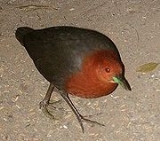
Red-necked Crake
Encyclopedia
The Red-necked Crake is a waterbird in the rail and crake family Rallidae
.
lowlands and adjacent islands, and north-eastern Australia
. They are found in tropical rainforest
s and dense vegetation close to permanent wetland
s.
s, aquatic invertebrate
s, crustacean
s and molluscs.
periods of which are around 20 days. The chicks emerge covered in black down
, precocial
and nidifugous
.
. The species is little studied and seldom seen due to its secretive nature, but appears to be locally common in New Guinea. In Australia it has suffered declines due to habitat loss.
Rallidae
The rails, or Rallidae, are a large cosmopolitan family of small to medium-sized birds. The family exhibits considerable diversity and the family also includes the crakes, coots, and gallinules...
.
Description
The Red-necked crake is a large crake (length 25 cm, wingspan 40 cm, weight 200 g). Its head, neck and breast are red-brown, with a paler version of that color on the throat. The upperparts are grey-brown, while the underparts are grey-brown with pale barring. The underwing is barred black and white, the bill green, and the legs grey-brown.Distribution and habitat
Red-necked crakes live in the Moluccas, Lesser Sundas, New GuineaNew Guinea
New Guinea is the world's second largest island, after Greenland, covering a land area of 786,000 km2. Located in the southwest Pacific Ocean, it lies geographically to the east of the Malay Archipelago, with which it is sometimes included as part of a greater Indo-Australian Archipelago...
lowlands and adjacent islands, and north-eastern Australia
Australia
Australia , officially the Commonwealth of Australia, is a country in the Southern Hemisphere comprising the mainland of the Australian continent, the island of Tasmania, and numerous smaller islands in the Indian and Pacific Oceans. It is the world's sixth-largest country by total area...
. They are found in tropical rainforest
Rainforest
Rainforests are forests characterized by high rainfall, with definitions based on a minimum normal annual rainfall of 1750-2000 mm...
s and dense vegetation close to permanent wetland
Wetland
A wetland is an area of land whose soil is saturated with water either permanently or seasonally. Wetlands are categorised by their characteristic vegetation, which is adapted to these unique soil conditions....
s.
Diet
The bird's diet consists of amphibianAmphibian
Amphibians , are a class of vertebrate animals including animals such as toads, frogs, caecilians, and salamanders. They are characterized as non-amniote ectothermic tetrapods...
s, aquatic invertebrate
Invertebrate
An invertebrate is an animal without a backbone. The group includes 97% of all animal species – all animals except those in the chordate subphylum Vertebrata .Invertebrates form a paraphyletic group...
s, crustacean
Crustacean
Crustaceans form a very large group of arthropods, usually treated as a subphylum, which includes such familiar animals as crabs, lobsters, crayfish, shrimp, krill and barnacles. The 50,000 described species range in size from Stygotantulus stocki at , to the Japanese spider crab with a leg span...
s and molluscs.
Breeding
The bird rests on or close to ground in dense vegetation. It lays clutches of 3-5 dull-white eggs, the incubationAvian incubation
Incubation refers to the process by which certain oviparous animals hatch their eggs, and to the development of the embryo within the egg. The most vital factor of incubation is the constant temperature required for its development over a specific period. Especially in domestic fowl, the act of...
periods of which are around 20 days. The chicks emerge covered in black down
Down
Down may refer to:* Relative direction, where down is the direction towards the centre of gravity of a celestial object.* Railroad directions, where down and up have locally significant meanings...
, precocial
Precocial
In biology, the term precocial refers to species in which the young are relatively mature and mobile from the moment of birth or hatching. The opposite developmental strategy is called "altricial," where the young are born or hatched helpless. Extremely precocial species may be called...
and nidifugous
Nidifugous
Nidifugous organisms are those that leave the nest shortly after hatching or birth. It is derived from Latin nidus for "nest" and fugere meaning "to flee". The terminology is most often used to describe birds and was introduced by Lorenz Oken in 1916...
.
Conservation
With a large range and no evidence of significant decline, this species is assessed as being of Least ConcernLeast Concern
Least Concern is an IUCN category assigned to extant taxon or lower taxa which have been evaluated but do not qualify for any other category. As such they do not qualify as threatened, Near Threatened, or Conservation Dependent...
. The species is little studied and seldom seen due to its secretive nature, but appears to be locally common in New Guinea. In Australia it has suffered declines due to habitat loss.

